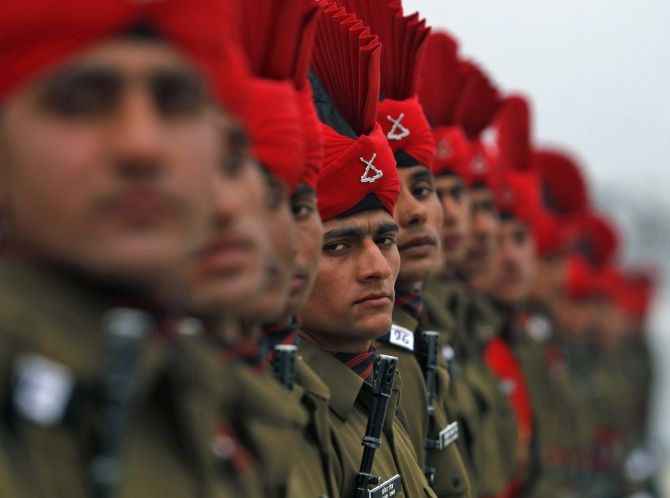The subcontinental man has a better record of fighting than Arabs, and what the Indian soldier has always needed is good leadership, says Aakar Patel.

I saw this story a few days ago and was surprised by it. It said the Islamic State, also called Isis and Daesh, "does not consider South Asian Muslims, including Indians, good enough to fight in conflict zone of Iraq and Syria and treat them as inferior to Arab fighters."
Because of this belief, "the fighters from South Asia are usually housed in groups in small barracks and are paid less than the Arab fighters and are provided inferior equipment," the report said.
This information came out of an intelligence report prepared by foreign agencies and shared with Indian agencies. It said fighters from India, Pakistan, Bangladesh as well as certain countries like Nigeria and Sudan are considered inferior to Arab fighters.
I do not know much about the history of warfare in Nigeria and Sudan. But I can assure the Arabs that the subcontinental man has a better record of fighting than them.
On the one hand it is a good thing that the Arabs are not using this asset because their cause is wrong. But on the other hand it may interest the reader to know the history so that the record can be set straight.
Professional Indian fighters first appear in history in 479 BC in Greece. This is at the Battle of Plataea between the Iranis and the Greek city states. The historian Herodotus tells us about the various formations on both sides, and describes the Indian contingent of mercenaries, hired by the Persian king Xerxes. I read the book a long time ago but I cannot remember if mercenaries from any other nation were hired: only from here.
The Indians give a good account of themselves in the battle, though the Persians lose.
The historian Arrian writes of events in Punjab a century later when Alexander the Great invaded. The only serious resistance he faced was from bands of mercenaries that villages hired to defend their settlements against the Macedonian army. The Indian mercenaries were very good at fighting. We know this because Alexander concludes a truce with them, then betrays them and massacres them.
This action is one of the few that his otherwise fawning biographers Arrian and Quintus Curtius Rufus single out as being morally reprehensible so we know it happened.
Indian soldiers have spilt and drawn blood in some of history's most fierce battles. The World War I fighting which made Turkey's Mustafa Kamal Ataturk famous in 1915 in Gallipoli included Indian soldiers, as many will know.
But most may not know that trench warfare, which defined that war, was an Indian invention.
In his book The First World War, military historian John Keegan wrote: ‘The first trench raid appears to have been mounted on the night of 9/10 November 1914 near Ypres by the 39th Garhwal Rifles of the Indian Corps. Fierce irruptions into enemy positions under cover of darkness was a traditional feature of Indian frontier fighting and this first murderous little action may have represented an introduction of tribal military practice into the ‘civilised’ warfare of western armies.’
There has been no shortage of courage and skill from the Indian fighter. In his work Catastrophe: Europe Goes To War 1914, historian Max Hastings, writes that ‘Indian troops taught the British the art of patrolling’.
There were so many Indians in the trenches in France that the British foreign office was asked to supply 10,000 live goats a month to meet the ritual dietary requirements of Indian troops.
The four volume work on the decline of the Mughal empire of the historian Sir Jadunath Sarkar shows the manner in which the three major Rajput clans (Sisodia, Kachwaha and Rathore) fought. Even when they were losing a battle, the Rathores continued to wheel their horses around and charge the enemy's guns again. This was because, Sir Jadunath writes, they felt that not enough of them had been killed for them to return with honour.
Of course, the problem of the Rajputs was that they mainly fought each other. In one battle, I was amazed to read, the full charge of a few dozen Rathores scattered one lakh rival Rathore fighters.
This is not the legacy or indication of a nation of fighters inferior to Arabs.
In a newspaper 15 years or so ago, I read of an instance where two British units fought in a bar after one of the groups got drunk and aggressive. Unfortunately for them, the other unit was the Gurkhas who, though much smaller in size than the Brits, were superior fighters and they, I still remember the line, "wiped the floor" with the opponents.
What the Indian soldier has always needed is good leadership. I doubt the Arabs of ISIS provide that and thank heavens for that.
Image: Indian Army recruits take part in their passing out parade at a garrison in Rangreth on the outskirts of Srinagar. Photograph: Danish Ismail/Reuters.









